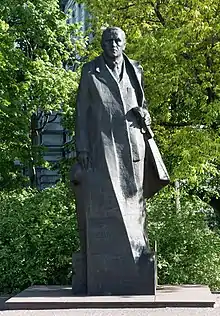Roman Dmowski Monument, Warsaw
The Roman Dmowski Monument in Warsaw (Polish: Pomnik Romana Dmowskiego w Warszawie) is a bronze statue, 5 meters (16 feet) tall, of Polish politician Roman Dmowski in Warsaw, on Na Rozdrożu Square at the intersection of Szuch and Ujazdów Avenues.[1] It was unveiled on 10 November 2006.[1] The statue holds a copy of the Treaty of Versailles[2] and carries a quotation from Dmowski's book: "I am a Pole, so I have Polish duties..." ("Jestem Polakiem więc mam obowiązki polskie...").[1] The monument has been controversial.[3]
Pomnik Romana Dmowskiego w Warszawie | |
 Roman Dmowski Monument (2022) | |
| 52°13′6.7″N 21°01′30.1″E | |
| Location | Na Rozdrożu Square, at the intersection of Szuch Avenue and Ujazdów Avenue, Warsaw, Poland |
|---|---|
| Designer | Wojciech Mendzelewski, Maria Marek-Prus, Piotr Prus |
| Type | Statue |
| Material | Bronze |
| Height | 5 metres (16 ft) |
| Completion date | 10 November 2006 |
| Dedicated to | Roman Dmowski |
Its construction was the result of an initiative supported by politicians Maciej Giertych, Bogusław Kowalski, and Jędrzej Dmowski.[4] The monument, sponsored by the Warsaw municipal council, cost the Polish government about 500,000 zlotys.[4] The unveiling ceremony was attended by some 200 people, including politicians Maciej Giertych, Artur Zawisza, and Wojciech Wierzejski, and by Father Henryk Jankowski, who consecrated the monument.[4]
The monument's location, near the offices of the Polish Ministry of Foreign Affairs on Szuch Avenue, relates to Dmowski's 1923 three-month tenure as Poland's minister of foreign affairs.[3]
Dmowski was the chief ideologue of Polish right-wing nationalism[4][5] and has been called "the father of Polish nationalism."[6][7] He is seen as a principal figure in the restoration of Polish independence after World War I, and was a signatory of the Treaty of Versailles.[8][9]
The monument has been called "one of the most controversial monuments in Warsaw"[3] and has led to protests from organisations which see Dmowski as a fascist opponent of tolerance; conversely, it has been a rallying icon for Polish right-wing nationalists (narodowcy).[4][10][11][12] Due to the controversies and protests, plans to raise statues or memorials to Dmowski elsewhere have generally been deferred.[13] Prominent critics of the monument have included Marek Edelman, a leader of the 1943 Warsaw Ghetto uprising; literary critic and theoretician Professor Maria Janion; and historian and sociologist Alina Cała.[4][14] Its notable defenders have included historian Jan Żaryn[15] and historian and politician Tomasz Nałęcz, who have emphasized Dmowski's important role in restoring Poland's independence.[2]
References
- Wydział Kultury i Promocji dla Dzielnicy Śródmieście Urzędu m.st. Warszawy. "Pomnik Romana Dmowskiego. Karta katalogowa - Karta ewidencji obiektu upamiętniajcego" (PDF) (in Polish). Retrieved 2013-09-19.
- Tomasz Nałęcz. "Nałęcz - Pomnik dla Dmowskiego - WPROST". Wprost.pl. Retrieved 2013-09-27.
- "Pomnik Romana Dmowskiego / pomnik / Wojciech Mendzelewski, Maria Marek-Prus, Piotr Prus" (in Polish). Puszka.waw.pl. Retrieved 2013-09-27.
- wiadomości.wp.pl. "Odsłonięto pomnik Romana Dmowskiego - Wiadomości - WP.PL" (in Polish). Wiadomosci.wp.pl. Retrieved 2013-09-19.
- Walicki, A. (1 December 1999). "The Troubling Legacy of Roman Dmowski". East European Politics & Societies. 14 (1): 12–46. doi:10.1177/0888325400014001002., p.46
- Jóhann Páll Árnason; Natalie Doyle (2010). Domains and Divisions of European History. Liverpool University Press. p. 93. ISBN 978-1-84631-214-4.
- Laura Ann Crago (1993). Nationalism, religion, citizenship, and work in the development of the Polish working class and the Polish trade union movement, 1815-1929: a comparative study of Russian Poland's textile workers and upper Silesian miners and metalworkers. Yale University. p. 168.
- Walicki, A. (1 December 1999). "The Troubling Legacy of Roman Dmowski". East European Politics & Societies. 14 (1): 12–46. doi:10.1177/0888325400014001002., p.14
- Walicki, A. (1 December 1999). "The Troubling Legacy of Roman Dmowski". East European Politics & Societies. 14 (1): 12–46. doi:10.1177/0888325400014001002., p.12
- "Dmowski zasłonięty balonami. Ale tylko w przenośni" (in Polish). M.wyborcza.pl. 2011-11-09. Retrieved 2013-09-19.
- "Protesty powitają pomnik Dmowskiego" (in Polish). Wiadomosci.gazeta.pl. Retrieved 2013-09-27.
- Rp.pl. "Atak na pomnik Dmowskiego - Archiwum Rzeczpospolitej" (in Polish). Archiwum.rp.pl. Retrieved 2013-09-27.
- "Roman Dmowski na pomnik. Białystok zrobi krok do tyłu?" (in Polish). Wyborcza.pl. 2002-02-03. Retrieved 2013-09-19.
- "Listy - List przeciw pomnikowi Romana Dmowskiego w Warszawie - Partia Zieloni 2004". Zieloni2004.pl. Retrieved 2013-09-27.
- "Wiadomości | wiadomości tv.rp.pl, informacje, ekonomia, prawo | rp.pl". Rzeczpospolita.pl. Retrieved 2013-09-27.